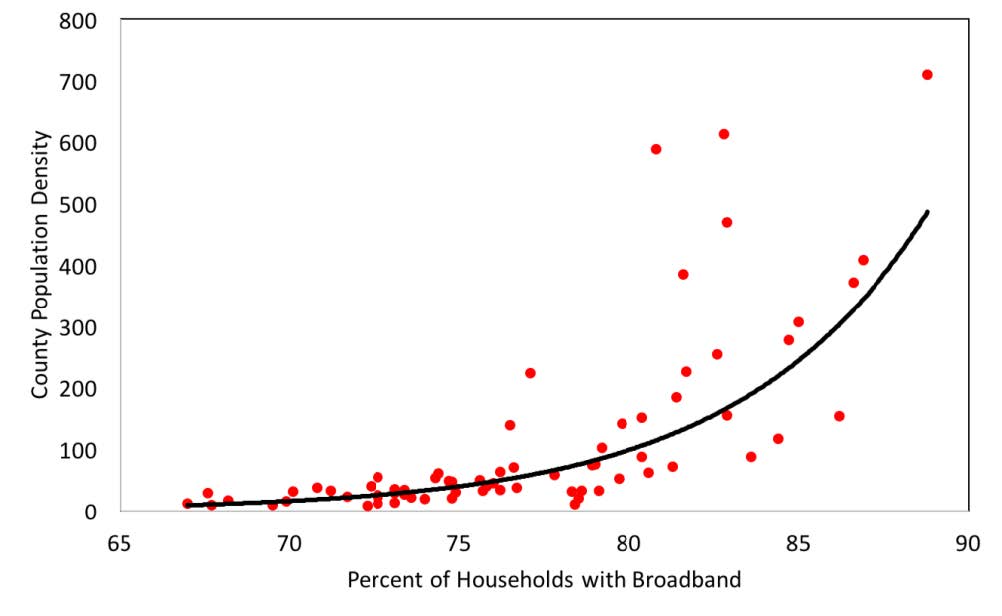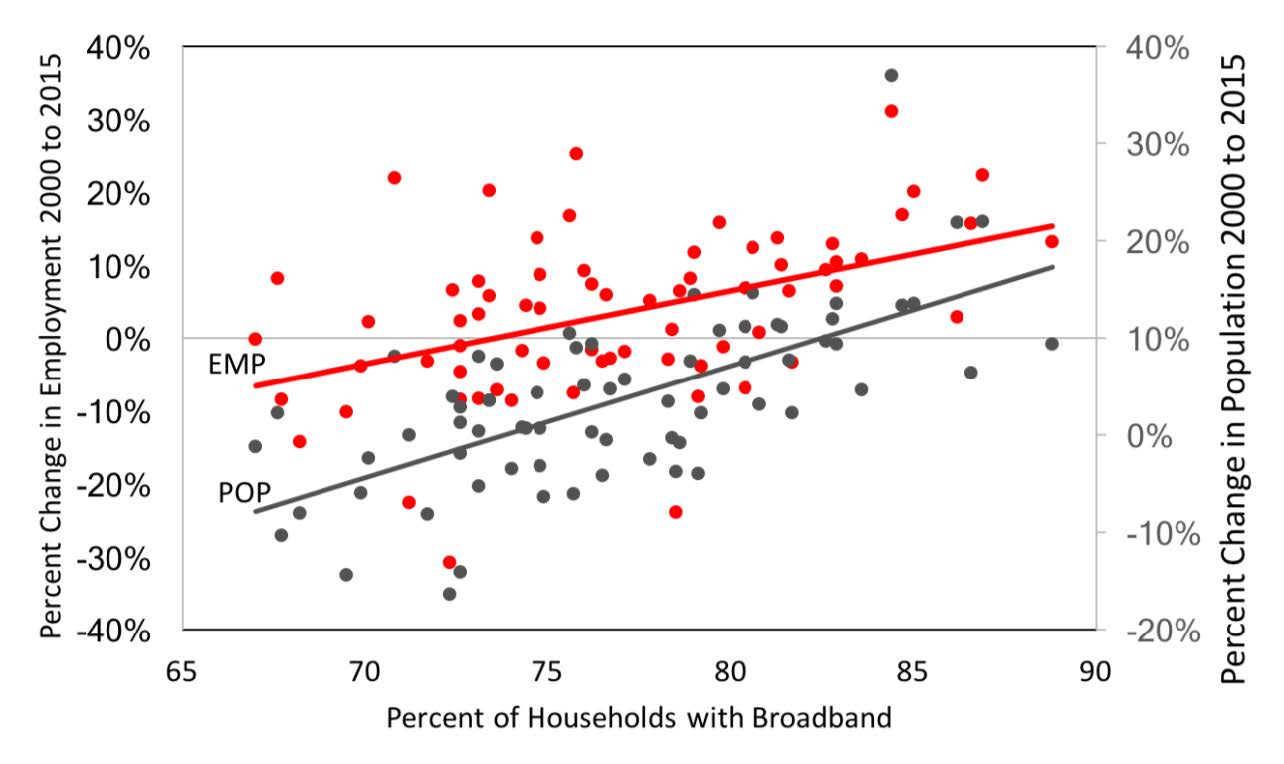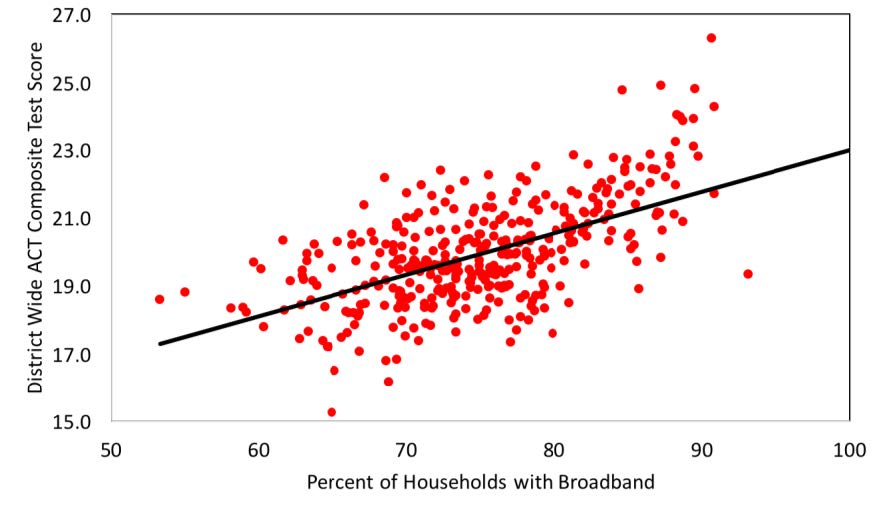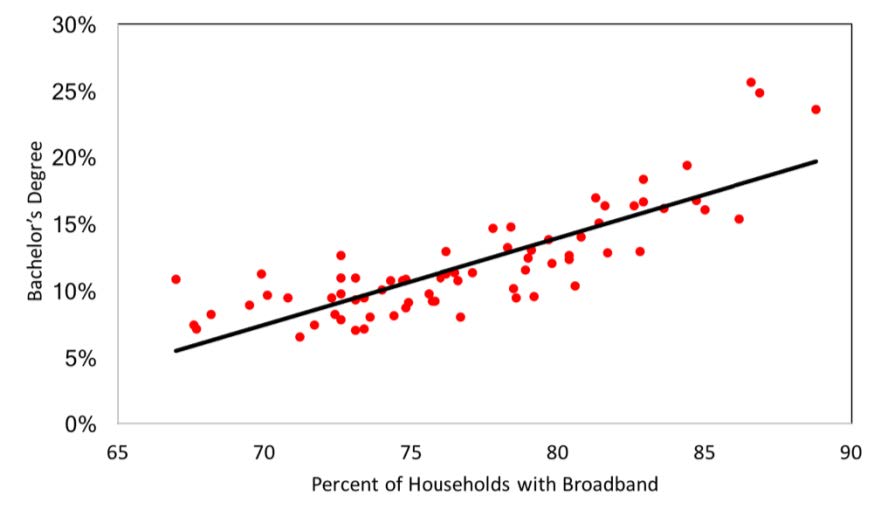KEY POINTS
- Broadband remains a concern to many Wisconsin residents and businesses, especially in rural areas.
- Broadband has become integral to education, work, health and quality of life.
- Broadband access is a particular problem for lower income households.
April 2020 — The Safer-At-Home order by Governor Evers put into effect starting March 25, 2020 in response to COVID-19 has drawn attention to the lack of adequate broadband in many parts of Wisconsin. As many employees work from home, students take their courses online, patients seek care through telehealth, and families entertain themselves at home with streaming services, access to broadband has become all the more apparent and the impacts more significant. Without access to adequate broadband service, employees find it difficult to work. Delivering education online begs the question of equity as some students are not able to access materials. Inability to use online services be them health-, entertainment-, or retail-related, make it more difficult to stay-at-home as ordered. Drawing further attention to the lack of adequate broadband is that many of the programs sponsored by the CARES Act aimed at helping off-set the effects of COVID-19 on the economy require access to broadband for applications and required forms making it difficult to enroll—compounding an already difficult set of circumstances.
Broadband Defined
The Federal Communication Commission (FCC) currently defines broadband as an internet connection with at least 25 Mbps (transfer of “mega bit per second”) of download speed and at least 3 Mbps of upload speed.
Inadequate broadband services have been an ongoing issue for years. Even before the COVID-19 public health emergency, rural communities have been at a comparative disadvantage due to inadequate access to broadband. Economically, a lack of broadband means lower home values, lower rates of entrepreneurship, and fewer opportunities for education. Stories of parents taking children to McDonald’s or parked outside of closed libraries to access wireless services so that the children can do their homework are becoming common.
Not only are students in underserved communities at a disadvantage but also adults who are pursuing new training or professional development opportunities. Inadequate service further limits telehealth, a potentially viable strategy to address limited access to healthcare in rural areas. These issues have only become more acute as Wisconsin residents spend more time at home and rely on service more and more to go about their daily lives as productively and comfortably as possible.
The Basics
Before exploring the patterns of broadband access and its impact on local communities, it is important to lay a foundation of what we mean by “broadband”. Broadband is a high-speed internet connection between homes, businesses, institutions (e.g., schools and local governments) or organizations (e.g., non-profits) through the world wide web. It is faster than a dial-up or narrow band telephone connection and it is continuously available making it preferable to other technologies. The Federal Communication Commission (FCC) currently defines broadband as at least 25 Mbps (transfer of “mega bit per second”) of download speed and at least 3 Mbps of upload speed. This speed is considered a “moderate” speed suitable for browsing the internet, email, streaming videos, web conferencing, and playing basic online games.
Rural Wisconsin generally has much lower rates of broadband access than urban Wisconsin, though some urban areas lack suitable access as well.
The are several different connection technologies that deliver broadband to houses and businesses including fiber, cable, DSL, wireless and satellite. Fiber, or fiber-optic, is generally viewed as the most preferred as it carries the greatest potential for transmitting large amounts of information (data). Cable uses the same coaxial cables that many use for cable television and is considered suitable for most broadband connections. DSL is also a wired technology but uses traditional copper telephone lines and is generally least preferred when compared to fiber or cable. Wireless technology is based on radio links and is generally connected to a fixed wire type connection (fiber, cable or DSL). Cellular is also a popular means to connect to the internet through the use of smartphones but quality of connection hinges on signal strength which can be spotty in rural areas. The final type of connection to the internet is via satellites and, for many rural residents and businesses, is the only option available.
Broadband infrastructure, or the means that all the pieces fit together, is often thought of in three segments: the backbone, middle mile, and the last mile. The backbone, usually fiber optic and capable of large volume data transmission, is owned by private providers, commercial, government, academic and other networks. The middle mile links the backbone to the Internet Service Providers’ (ISP) or telecommunications providers’ main network. The middle mile can connect anchor institutions in some communities so that they can share applications, infrastructure, and other resources. The last mile connects homes and small businesses to the middle mile. One can think of this infrastructure parallel to how electricity is distributed: high voltage powerlines transport large volumes of electricity over great distances and are connected to regional distribution networks, when then are connected to neighborhood distribution networks. The backbone would be the high voltage powerlines, the middle mile is the regional distribution network, and the last mile is the neighborhood system of powerlines.
Broadband in Wisconsin
Access to broadband of any type varies considerably across the country. Consider the percent of households that have broadband of any type (wired, cellular, satellite) in the map below.
 One of the challenges to understanding the availability of broadband is the lack of quality data. The data from the Federal Communication Commission (FCC) generally overreport broadband coverage. Although President Trump signed the Broadband Deployment Accuracy and Technological Availability (DATA) Act (March 23, 2020) with the aim to address some of these concerns, those data will not be available for several months. To avoid the problems with the FCC data we use U.S. Census Bureau data from the American Community Survey, specifically the 2018 5-year averages. Beginning a few years ago the Census began to ask households about access and use of the internet.
One of the challenges to understanding the availability of broadband is the lack of quality data. The data from the Federal Communication Commission (FCC) generally overreport broadband coverage. Although President Trump signed the Broadband Deployment Accuracy and Technological Availability (DATA) Act (March 23, 2020) with the aim to address some of these concerns, those data will not be available for several months. To avoid the problems with the FCC data we use U.S. Census Bureau data from the American Community Survey, specifically the 2018 5-year averages. Beginning a few years ago the Census began to ask households about access and use of the internet.
Larger metropolitan areas are easily identifiable such as Chicago, the Twin Cities, Atlanta and Seattle, amongst others, where the share of households with broadband tend to be higher. More important is the relatively low rates in rural communities. In Wisconsin, Waukesha, Dane and Ozaukee counties have the highest coverage rates at 88.8, 87.5 and 87 percent, respectively. Not only are these some of the larger counties in terms of population, but also counties with some of the highest income levels. The three counties with the lowest access rates are Menominee (67%), Clark (67.6%) and Forest (67.7%) counties.
It is clear from the Census data that rural Wisconsin generally has much lower rates of broadband access than urban Wisconsin, though some urban areas lack suitable access as well. This clearly places rural Wisconsin at a comparative disadvantage compared to urban Wisconsin when it comes to economic competitiveness and overall community well-being. A simple plotting (Figure 1) of Wisconsin county population density and percent of households with broadband, reveals a clear positive relationship: more rural counties have a smaller share of households with broadband.

Households may not have broadband services for several reasons including lack of service access, no interest in having internet services, and/or inability to pay for services, among others. The first issue is one of supply: it is not cost effective for service providers to make the investments to bring the infrastructure required to potential customers. For example, many smaller communities have a sufficient population density to make investment in the broadband infrastructure a viable business decision for service providers. But when it comes to reaching households in the periphery, immediately outside of that community, the investment in the “last mile” is not cost effective for the service provider. This can be compounded in areas that have an abundance of lakes and rivers or more mountainous terrain. For many rural Wisconsin residents, these last two geographical features can be particularly difficult to overcome.
The other issue is related to the costs of services and the ability of lower income households to pay for the services even if the service is available. Consider Ozaukee County, one of the wealthiest counties in Wisconsin, only 4.5% of households with annual incomes greater than $75,000 do not have broadband, but 38.2% of households with incomes less than $20,000 have no broadband. In Juneau County, one of the lowest income counties, 10.9% of households with income greater the $75,000 a year did not have broadband, but for households with income less than $20,000 48.2% do not have broadband. Clearly, lower income households are less likely to have broadband which is reflective not only of lack of access but also inability to pay for services. For low income households with children, this places these children at a disadvantage in terms of their ability to access on-line learning resources and do their homework.
Economic Impacts
While broadband may have once been thought a luxury, today it is a necessity. Many facets of the local economy hinge on broadband service. To get a general sense of the impacts in Wisconsin counties, we consider the correlation between broadband and several economic indicators. First, using data for all 72 Wisconsin counties we find that counties with a higher share of households that have broadband tended to experience higher rates of growth in both population and employment (Figure 2).

These simple growth results are consistent with the research findings indicating that higher broadband coverage results in both higher housing prices and business startups in rural areas. At the simplest level, counties that are experiencing population and employment growth tend to be more dynamic and this is reflected in the housing market as well as rates of entrepreneurship. Research by Deller and Whitacre (2019) found that a 10% increase in broadband coverage of at least 0.2 Mbps results in the median rural house value increasing by $661. The result is consistent with the anecdotal evidence by real estate agents that houses in rural areas that are not wired for broadband tend to sit on the market longer than similar houses that are wired. Studies by both Conroy and Low (2020) and Deller, Whitacre and Conroy (2019) find that rural counties that have higher levels of broadband access have higher business startups rates (entrepreneurship).
There is also a growing pool of applied research that suggests that access to broadband has impacts on the well-being of the community beyond traditional measures of economic performance. For example, the Safer-At-Home order by Governor Evers which has resulted in all educational institutions, including all K-12 systems, the technical college system, the University of Wisconsin and all private educational institutions, to close face-to-face interaction and shift educational programs to on-line formats. This shift presumes students have adequate access to the internet (i.e., broadband). Even absent the governor’s order, routine educational programs at all levels are increasingly relying on the internet for the delivery of core elements of courses. In addition, numerous continuing educational and professional development programs are provided on-line which requires access to broadband.
This line of thinking suggests that students who have access to broadband should have higher educational outcomes than those students who do not have access. To gain some insights into this potential relationship consider the percent of households within Wisconsin school districts and the average composite college entrance exam ACT score. As expected, there is a strong positive relationship: Wisconsin school districts that have a higher concentration of households with any form of broadband tend to also have higher average ACT test scores (Figure 3). One must be careful in drawing too strong of a conclusion from this simple scatter plot. From the prior descriptive analysis, it is clear that access to broadband is related to income and at the same time household income is related to test scores. It may be the case that the household income is driving the underlying relationship between broadband and test scores. With this caution in mind, the correlation still is suggestive of the importance of broadband for education. Most likely, students that lack access to on-line educational resources are at a comparative disadvantage.

A second way to explore the education and broadband relationship is to map the share of the population (age 25 and over) that has a college degree (bachelors) and household access to broadband. Again, using the U.S. Census Bureau American Community Survey data, there is a strong positive relationship: Wisconsin counties that have a higher percentage of households that have broadband also have a higher percentage of people with a bachelor’s degree (Figure 4). The argument linking access to broadband and college entrance exam schools is more intuitive, but the link between broadband and college degrees is more tenuous. People with college degrees have generally chosen the community in which they live, whether for employment opportunities or personal preferences, such as the desire to return home after completing their degree. Here we see it is more likely that people with a college degree are also more inclined to locate in a community (or county) that has sufficient access to broadband.
There are numerous examples of rural communities that have attempted to recruit younger people to move into their communities, but the lack of access to broadband becomes a problem. This is particularly true for communities that encourage their youth to attend college, experience “big city life” and then return home to work, live and contribute to the community (boomerang migration). The lack of broadband has proven to be a serious hurdle that many rural communities struggle to overcome. The policy implication is that if the community wants to be attractive to in-migrants with higher levels of education, investing in broadband is a likely part of successful strategy.

The final way that we explore how access to broadband impacts the economy is through health outcomes. It is widely accepted that individual health has both direct and indirect impacts on labor productivity and hence the economy (Deller 2020). Improved health outcomes improve labor productivity, income and industrial output. The link to broadband is often through the lens of telehealth where patients can access medical health practitioners through web conferencing (e.g., Jennett 2003). Increasingly, nurse practitioners can conduct in-house visits and access the necessary technologies through the internet. These connections, however, require broadband level speeds and consistency of connection quality. Health outcomes can also increase through access to health care information such as magazines and internet bases resources such as WebMD, Healthline or MedLine Plus.
Conclusion
The academic research coupled with the simple descriptive analysis using
Wisconsin counties as a unit of analysis presented in this WIndicator show that there is a clear relationship between access to broadband and economic
performance and overall community well-being. As stated elsewhere in this WIndicator, investment in broadband is no longer a luxury then allows people to stream Netflix or look up the latest Badgers rankings in the national polls, but rather a necessity for a functioning modern economy. The Safer-At-Home policy has exposed how access to broadband is vital to education, work, health, and quality of life in general.
There are at least two factors driving the broadband divide, namely the lack of investment in the physical infrastructure, particularly the “last mile”, and income, or the ability to pay for services. These challenges are important to overcome as the personal, economic, and community benefits of broadband are becoming clearer. In Wisconsin, particularly rural Wisconsin, improved access (alongside affordability and adoption) of broadband could lead to many improved outcomes and an opportunity to better bridge our rural and urban communities. Access to reliable and affordable broadband is no longer just sufficient for economic growth and development, but is now a necessity.
References
Conroy, Tessa and Sarah Low. (2020). “The Need for Speed: Rural Broadband and Entrepreneurship by Business Size and Gender.” Paper to be presented at the 59th Annual Meetings of the Southern Regional Science Association. Savanah GA.
Deller, Steven C. (2020). “Access to Health Care and Rural Worker Productivity.” Paper to be presented at the 59th Annual Meetings of the Southern Regional Science Association. Savanah GA.
Deller, Steven C., Brian Whitacre and Tessa Conroy. (2019). “Broadband Speed and Business Startup Rates.” Paper presented at the Southern Regional Science Association Meetings. Arlington, VA.
Deller, Steven, and Brian Whitacre. (2019). “Broadband’s Relationship to Rural Housing Values.” Papers in Regional Science. 98(5): 2135-2156.
Jennett, Penny. (2003). “Socio-Economic Impact of Telehealth: Evidence Now for Health Care in the Future. Final Report.” University of Calgary.
Broadband & E-Commerce Education Center. University of Wisconsin Extension Madison. “Broadband Reference Guide: A Digital Resource for Stakeholders.” January, 2014.
Funding: This work was supported by a grant from the United States Department of Commerce Economic Development Administration in support of Economic Development Authority University Center (Award No. ED16CHI3030030). Any opinions, findings, conclusions or recommendations expressed in this material are those of the authors and do not necessarily reflect the views of the U.S. Department of Commerce Economic Development Administration.
Download Article

 What's Next in Wisconsin Broadband, November 2025 -
What's Next in Wisconsin Broadband, November 2025 - Broadband Expansion in Wisconsin: Case Studies - Page 3
Broadband Expansion in Wisconsin: Case Studies - Page 3


